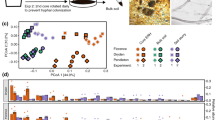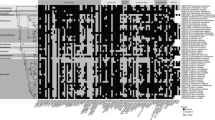Abstract
Mucor ramannianus is one of the commonest fungi occurring in certain acid, sandy soils, and often, in some horizons, may be the only fungus isolated by standard plating methods. In grassland soils at Lakenheath Warren it was confined to those of low pH value1, and Thornton2 found it to be very common in podsolized soils beneath Calluna vulgaris L., but absent from soils of similar derivation beneath mixed oakwood. M. ramannianus was a characteristic fungus in six out of nine acid, heath soils examined by Jefferys, Brian, Hemming and Lowe3, who suggested that its presence was related to the existence of a well-marked iron-pan in the B horizon. McLennan and Ducker4,5 have further suggested that a predominance of M. ramannianus is indicative of acid, sandy soil types with a well-defined pan layer. Detailed studies, primarily of a physiological nature, have been described by Müller6, who concluded that not only the presence of growth factors but also the hydrogen ion concentration of the soil and source of carbon would play an important part in limiting its distribution. M. ramannianus was among the commonest species encountered by us in soils and on roots during detailed surveys of the mycofloras of some British dune systems7 and Calluna-heathlands8 ; its distribution was closely related to certain soil conditions which are discussed below. These observations are presented in view of the fragmentary and sometimes conflicting data available on the ecology of this interesting species.
This is a preview of subscription content, access via your institution
Access options
Subscribe to this journal
Receive 51 print issues and online access
$199.00 per year
only $3.90 per issue
Buy this article
- Purchase on Springer Link
- Instant access to full article PDF
Prices may be subject to local taxes which are calculated during checkout
Similar content being viewed by others
References
Warcup, J. H., Trans. Brit. Mycol. Soc., 34, 376 (1951).
Thornton, R. H., Trans. Brit. Mycol. Soc., 39, 485 (1956).
Jefferys, E. G., Brian, P. W., Hemming, H. G., and Lowe, D., J. Gen. Microbiol., 9, 314 (1953).
McLennan, E. I., and Ducker, S. C., Nature, 174, 1060 (1954).
McLennan, E. I., and Ducker, S. C., Aust. J. Bot., 5, 36 (1957).
Müller, F. W., Ber. schweiz. bot. Ges., 51, 165 (1941).
Brown, J. C., Ph.D. thesis, University of London (1957).
Sewell, G. W. F., Ph.D. thesis, University of London (1954).
Warcup, J. H., Nature, 166, 117 (1950).
Simmonds, P. M., Phytopathol., 20, 911 (1930).
Thrower, L. B., Aust. J. Bot., 2, 246 (1954).
Sewell, G. W. F., Nature, 177, 708 (1956).
Stenton, H., Trans. Brit. Mycol. Soc., 36, 304 (1953).
Author information
Authors and Affiliations
Rights and permissions
About this article
Cite this article
SEWELL, G., BROWN, J. Ecology of Mucor ramannianus Moller. Nature 183, 1344–1345 (1959). https://doi.org/10.1038/1831344a0
Issue Date:
DOI: https://doi.org/10.1038/1831344a0
This article is cited by
-
Population micromycetique de quelques types forestiers du Plateau du Sart Tilman (Liege, Belgique)
Plant and Soil (1965)
-
Das Pilzspektrum einer Bodenprobe
Archiv f�r Mikrobiologie (1960)
Comments
By submitting a comment you agree to abide by our Terms and Community Guidelines. If you find something abusive or that does not comply with our terms or guidelines please flag it as inappropriate.



